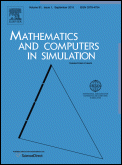Mathematics and Computers in Simulation (MATCOM) Special Issue

Discontinuous Dynamical Systems:Theory and Numerical Methods
There is a growing realization within the engineering, physical, biological, medical and social sciences that
many nonlinear behaviors can be explained by discontinuities. A system with a discontinuous nonlinearity is
sometimes referred to as a discontinuous dynamical system (DDS) or a nonsmooth dynamical system (NSDS),
which are both collective names to encompass such systems. The mathematical formalisms which are commonly
used are differential inclusions, complementarity dynamical systems, evolution variational inequalities and
piecewise-smooth systems. The common point between all these formalisms is a certain degree of nonsmoothness
(they all possess solutions which are at most continuous, sometimes with jumps). The discontinuities in DDSs
can have many different origins and manifestations. One classic example is a mechanical system that can
experience discontinuities in the forms of both impacts and friction. These two phenomena are modelled in
different ways and also lead to different dynamical behaviours. Analysis of DDSs in general often requires
special theoretical attention and novel techniques since analysis methods for smooth dynamicial systems are
not always sufficient. In recent years there has also been an increased amount of research into numerical
methods for DDSs. However, the large number of possible system types together with a variety of different
discontinuities makes it very hard to develop numerical methods that can deal with all the possibilities.
Therefore, to develop general analytical and numerical methods for DDSs remain open areas of research, but
any success would have huge implications in many fields of science.
The Guest Editors of the Special Issue Discontinuous Dynamicial Systems: Theory and Numerical Methods invite
you to submit a paper for possible publication in Elsevier's Journal MATCOM (http://ees.elsevier.com/matcom).
The Special Issue is now closed for submissions.
According to the Journal's policy all submitted papers for consideration for inclusion in the Special Issue
must contain original unpublished work that is not submitted for publication elsewhere and does not exceed 20 pages.
All contributed papers will undergo the usual refereeing process.
Submit your contribution directly via the MATCOM website at http://ees.elsevier.com/matcom. For this, register as the
corresponding author (get a login and a password). Next, login as author and submit the contribution. During this
procedure, it is ESSENTIAL that the article type is specified as "DDS 2010". Otherwise, the paper might follow a
different route for regular MATCOM issues and will not reach us at all.
Please note that manuscripts should be written preferably in LaTeX and in any
case conform to the requirements of our Guide for Authors printed in any
MATCOM issue and also available on MATCOM's webpage. You should use
appropriate LaTeX class and bibliographic style files to have the requested
presentation automatically. You can use elsart.cls as class file and
elsart-num-sort.bst as bibliographic style file (both available on CTAN and
Elsevier websites). You can also use elsarticle.cls as class file and
model1b-num-names.bst as bibliographic style file (both downloadable from
http://www.elsevier.com/wps/find/authorsview.authors/elsarticle along with a template if you need one).
The Guest Editors of the Special Issue:
Bernard Brogliato (Bernard.Brogliato@inrialpes.fr)
Tassilo Küpper (kuepper@math.uni-koeln.de)
Luciano Lopez (lopezl@dm.uniba.it)
Petri Piiroinen (petri.piiroinen@nuigalway.ie)

